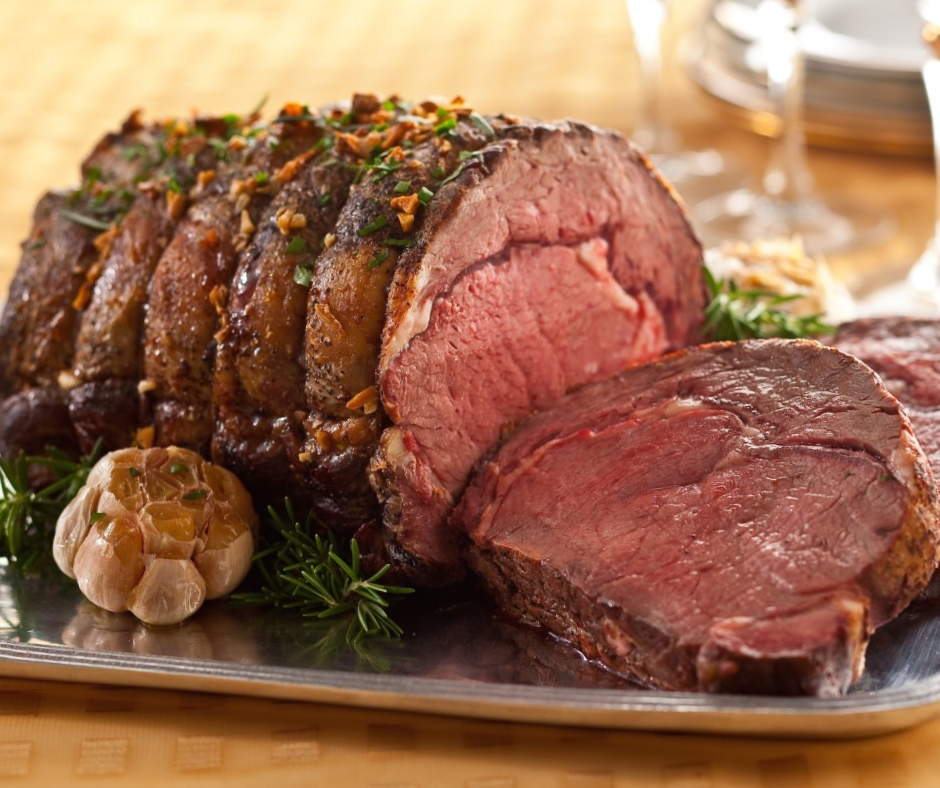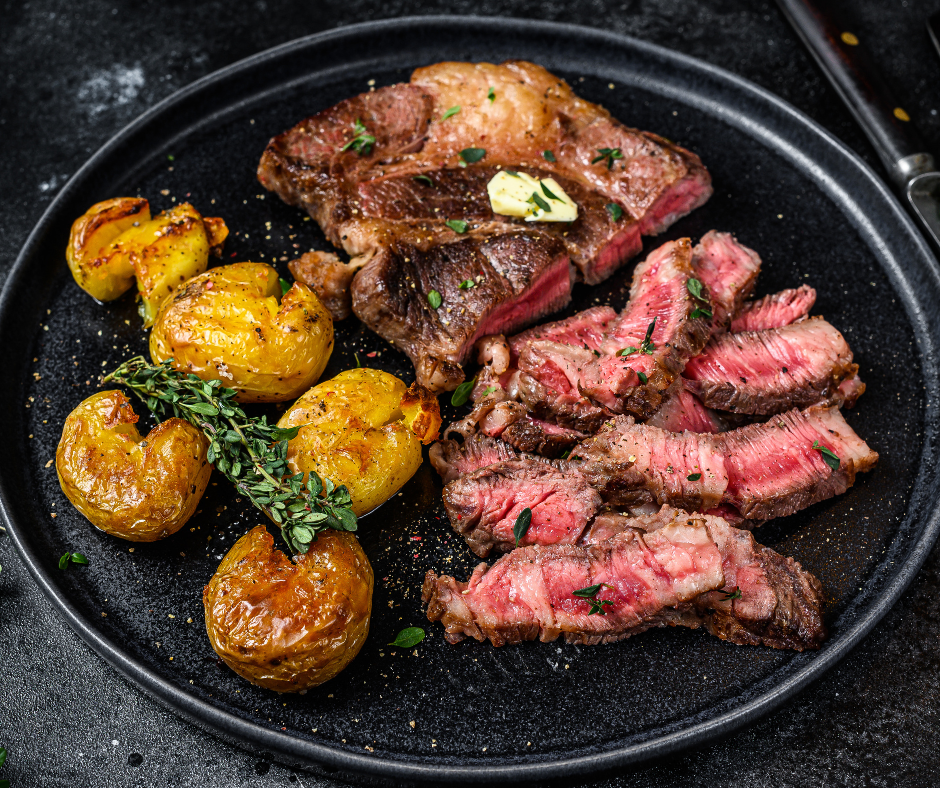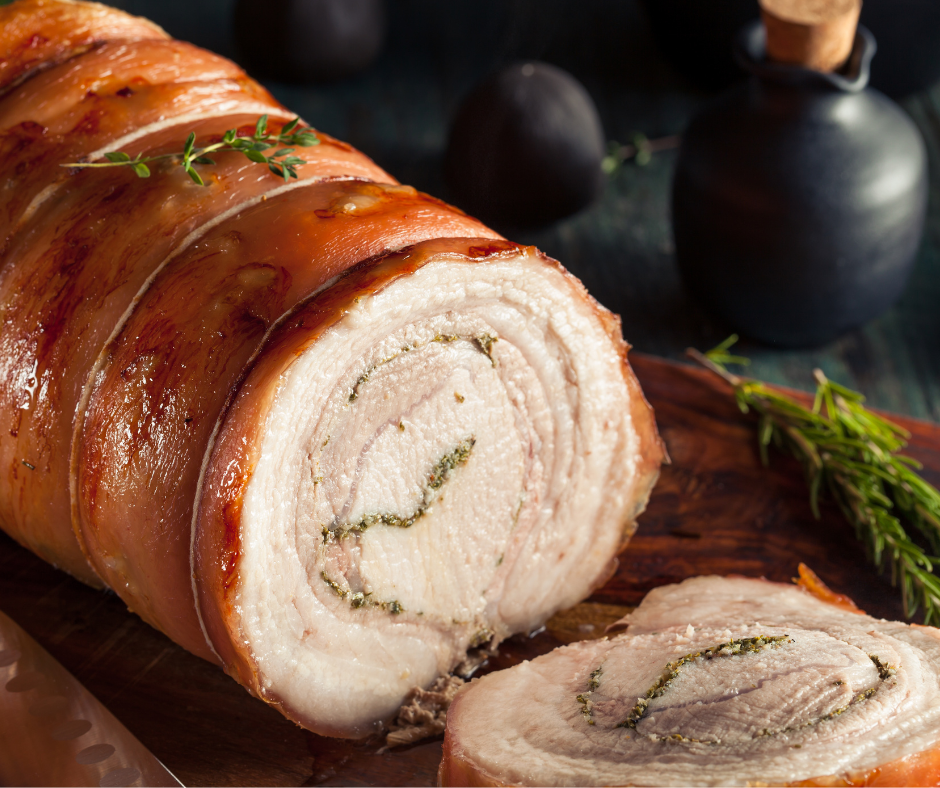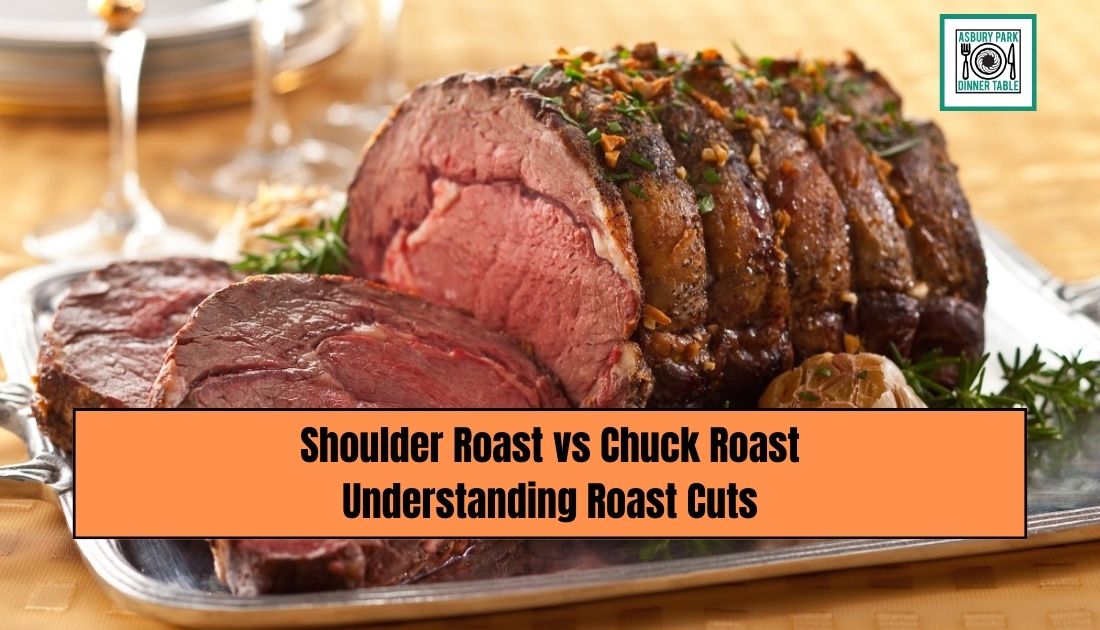Introduction
When choosing the perfect cut of beef for a roast, two popular options are shoulder roast and chuck roast. While both cuts offer delicious flavors, notable differences can influence your choice. Understanding the differences when comparing Shoulder Roast vs Chuck Roast can help you make an informed decision and create a mouthwatering roast for your next meal.
Understanding The Difference Between Shoulder Roast And Chuck Roast
Shoulder Roast is a heavily exercised muscle cut from the cow’s shoulder. This makes it a flavorful cut with rich marbling and a slightly tough texture. On the other hand, Chuck Roast is taken from the cow’s shoulder area, specifically the upper portion closer to the neck. It is also a well-marbled cut, but it tends to be slightly more tender than shoulder roast.
Regarding cooking methods, both cuts are versatile and can be prepared in various ways. However, due to its tougher texture, shoulder roast typically requires a longer cooking time than chuck roast. Slow cooking methods such as braising or roasting at a low temperature are recommended for shoulder roasting to achieve a tender and succulent result. On the other hand, Chuck roast can be cooked using similar methods but may require slightly less cooking time.
The Factors To Consider When Choosing Between The Two Cuts
When deciding between shoulder roast and chuck roast, there are a few factors to consider. Firstly, tenderness plays a role. If you prefer a more tender cut of meat, chuck roast might be the better choice for you. However, if you enjoy the flavor of a heavily exercised muscle, shoulder roast could be your go-to option.
Another important factor to consider is the time required for preparation. As mentioned earlier, shoulder roast typically requires longer cooking than chuck roast. If you have limited time available for cooking, chuck roast might be a more practical choice.
Lastly, personal preference and the dish you prepare should also be considered. Shoulder and chuck roast can produce delicious and satisfying meals when cooked properly. Consider the flavors and textures you prefer and the specific recipe you plan on using.
In conclusion, understanding the differences between shoulder and chuck roast is crucial in choosing the right cut for your beef roast. Both cuts provide delicious results, but the location, tenderness, and cooking methods may vary. Whether you prefer a tender and succulent slow-cooked roast or a versatile cut that can be prepared differently, these beef cuts offer a range of options to satisfy your taste buds. Whichever cut you choose, with proper preparation and cooking, you’re sure to create a delicious and satisfying roast for your next meal.

Shoulder Roast
What Is Shoulder Roast?
Shoulder roast, also known as pork shoulder or Boston butt, is a cut of meat taken from the shoulder of a pig. It is a heavily exercised muscle, which gives it a unique flavor and texture. The shoulder roast is typically bone-in and contains a good amount of fat that adds to its flavor during cooking.
Flavor Profile And Tenderness Of Shoulder Roast
The shoulder roast is known for its flavorful taste. It has rich marbling throughout the meat, which adds to its juiciness. Due to the exercise that the shoulder muscle goes through, the meat can be slightly tough. However, when cooked properly, it becomes tender and juicy.
Regarding tenderness, the shoulder roast can benefit from slow cooking methods such as braising or roasting at a low temperature. These methods break down the tough fibers in the meat and result in a tender and melt-in-your-mouth texture.
The flavor profile of shoulder roast is robust and savory. The fat content in the meat contributes to its moistness and enhances its flavor during cooking. It is a versatile cut that can be used in various dishes, such as pulled pork, stews, or roasted vegetables.
Compared to chuck roast, shoulder roast offers a slightly different taste and tenderness. The chuck roast tends to be more tender due to its location on the cow’s shoulder closer to the neck, whereas shoulder roast requires a longer cooking time to achieve optimum tenderness.
In conclusion, shoulder roast is a flavorful cut of meat from the pig’s shoulder. It has rich marbling and offers a robust taste. While it may be slightly tough, slow cooking can transform it into a tender and succulent dish. The choice between shoulder roast and chuck roast ultimately depends on personal preference and the specific recipe you are preparing.
Chuck Roast
What Is Chuck Roast?
Chuck roast, also known as chuck eye roast or chuck shoulder roast, is a cut of meat taken from the shoulder or neck area of the cow. It is a well-exercised muscle, which gives it a rich flavor and hearty texture. The chuck roast is typically bone-in and contains a good amount of marbling, which adds to its flavor during cooking.
Flavor Profile And Tenderness Of Chuck Roast
Chuck roast is known for its robust and beefy taste. It has a good amount of fat marbling throughout the meat, contributing to its juiciness and enhancing the flavor during cooking. The location of the chuck roast closer to the neck results in a more tender cut than the shoulder roast.
Although chuck roast is generally more tender, it still benefits from slow cooking methods such as braising or roasting at a low temperature to enhance its tenderness further. The connective tissues in the meat break down during the long cooking process, resulting in a melt-in-your-mouth texture.
Chuck roast is a versatile cut that can be used in various dishes. It is commonly used for pot roasts, stews, and slow-cooked dishes like beef bourguignon. The flavorful and tender meat pairs well with bold flavors and can be easily shredded for sandwiches or tacos.
Both cuts offer distinct flavors and textures when comparing shoulder roast vs. chuck roast. With its rich marbling and unique flavor, the shoulder roast requires a longer cooking time to achieve optimal tenderness. On the other hand, chuck roast is inherently more tender and has a robust beefy taste.
In conclusion, shoulder roast and chuck roast are flavorful cuts of meat that can be used to create delicious dishes. Each cut has its distinct qualities in terms of taste and tenderness. The choice between shoulder roast and chuck roast ultimately depends on personal preference and the specific recipe you are preparing. Whether you prefer the robust and slightly tougher shoulder roast or the tender and beefy chuck roast, both cuts can produce a satisfying and flavorful roast when cooked properly.

Shoulder Roast vs Chuck Roast: Fat Content And Marbling
One significant difference in comparing Shoulder Roast vs Chuck Roast lies in their fat content and marbling. Shoulder roast typically contains less fat than chuck roast. This makes it a good choice if you want to balance flavor and leanness. On the other hand, chuck roast has a fair amount of fat, contributing to a richer flavor but requiring longer cooking times to tenderize.
Marbling, the dispersion of fat throughout the meat, is an essential aspect of both shoulder roast and chuck roast. The shoulder roast has decent marbling but may not be as consistent as the chuck roast. This means that chuck roast has more marbling overall, resulting in a more tender and melt-in-your-mouth texture when cooked slowly. The marbling also ensures that the meat remains moist and flavorful during cooking.
The higher fat content in the chuck roast contributes to its robust beefy taste. With shoulder roast, although it has less fat, it retains enough connective tissue to keep the meat moist and tasty during cooking. It is important to note that cuts with higher marbling, such as ribeye or striploin, have a rich buttery flavor because of well-distributed fat.
Regarding cooking methods, shoulder roast, with its lower fat content and slightly tougher texture, benefits from slow cooking techniques such as braising or roasting at a low temperature. These methods help break down the connective tissue and produce a tender and flavorful roast.
On the other hand, chuck roast, with its higher fat content and more marbling, is inherently more tender. It can be cooked using various methods, including slow cooking and grilling. The rich flavor and juiciness of chuck roast make it a versatile cut in dishes like pot roasts, stews, or slow-cooked dishes like beef bourguignon.
In conclusion, it is essential to consider the difference in fat content and marbling when comparing shoulder roast and chuck roast. Shoulder roast typically contains less fat and has decent marbling, while chuck roast has more fat and abundant marbling. Both cuts offer distinct flavors and textures and can create delicious dishes. The choice between shoulder roast and chuck roast ultimately depends on personal preference and the desired cooking method.
Similarities And Versatility
Similarities Between Shoulder Roast And Chuck Roast
Shoulder roast and chuck roast share some similarities that make them both versatile cuts of meat. Both cuts are popular choices for stews, slow-cooked curries, and roasts. They offer a hearty, beefy flavor perfect for comfort food recipes. Whether you choose shoulder roast or chuck roast, you can expect a depth of flavor that adds richness to your dishes.
In addition to their similarities in taste, shoulder roast, and chuck roast can also be cooked using similar methods. Both cuts benefit from slow cooking techniques such as braising or roasting at a low temperature. These methods help break down the tough connective tissues in the meat and result in a tender and flavorful roast.
Versatility And Usage In Various Recipes
Both shoulder roast and chuck roast are incredibly versatile cuts of meat that can be used in various recipes. From classic pot roasts to flavorful stews, these cuts offer endless possibilities in the kitchen.
Shoulder roast, with its slightly leaner meat, is particularly well-suited for dishes that require longer cooking times, such as braises and slow roasts. The connective tissues in the meat break down during cooking, resulting in a tender and succulent roast. This makes shoulder roast great for recipes like pulled pork or slow-cooked curries.
On the other hand, chuck roast’s higher fat content and abundant marbling make it inherently tender and flavorful. It can be cooked using various methods, including slow cooking and grilling. Chuck roast is perfect for pot roasts, stews, or slow-cooked dishes like beef bourguignon. The rich flavor and juiciness of chuck roast elevate these dishes to new levels of deliciousness.
In conclusion, the comparison of Shoulder Roast vs Chuck Roast offers similarities in taste and cooking methods, making them versatile cuts that can be used in various recipes. They both provide a depth of flavor that adds richness to dishes, but their choice ultimately depends on personal preference and the desired cooking method. Whichever cut you choose, both shoulder roast and chuck roast will impress with their delicious and satisfying results.

Differences In Texture And Flavor
Texture Differences Between Shoulder Roast And Chuck Roast
Shoulder roast and chuck roast may seem similar, but they have distinct texture differences that can impact the overall taste and tenderness of the meat.
Shoulder roast, a blade or arm roast, has a slightly fattier texture. This marbling of fat throughout the meat helps keep it moist and tender during cooking. As the roast cooks, the fat melts, creating a flavorful and succulent result. The connective tissues in the shoulder roast also break down during cooking, contributing to its tenderness.
On the other hand, chuck roast has a good amount of intramuscular fat, also known as marbling. This fat gives the roast a more tender and juicy result. The higher fat content in the chuck roast translates into a rich and robust flavor.
Flavor Profiles And Preferences
The flavor profiles of Shoulder Roast vs Chuck Roast are also distinct. Shoulder roast, with its higher fat content, has a rich and succulent flavor that adds depth to any dish. The marbled fat provides moisture and contributes to the overall juiciness of the meat.
On the other hand, Chuck roast is known for its robust beefy flavor. The abundance of marbling enhances the taste, resulting in a tender and juicy experience. This makes chuck roast popular for hearty dishes like pot roasts and stews.
Regarding personal preferences, some individuals may prefer the slightly leaner meat of shoulder roast, which still delivers a robust beefy taste without excessive fat. The shoulder roast is versatile and can be used in recipes requiring longer cooking, such as braises and slow roasts.
For those who enjoy melt-in-your-mouth tenderness and full-bodied flavor, chuck roast is an excellent choice. Its higher fat content and abundant marbling make it inherently tender and succulent. Chuck roast can be cooked using various methods, including slow cooking and grilling, allowing for various culinary possibilities.
In conclusion, shoulder roast and chuck roast are flavorful cuts of meat with unique characteristics. The texture and tenderness differ, with shoulder roast having a slightly fattier texture that melts during cooking, while a chuck roast benefits from abundant marbling for a tender and juicy result. The flavor profiles also vary, with shoulder roast offering a rich and succulent taste and chuck roast delivering a robust beefy flavor. Ultimately, the choice between shoulder roast and chuck roast boils down to personal preference and the specific dish you are preparing.
Cooking Techniques And Recipes
Recommended Cooking Techniques For Shoulder Roast
The shoulder roast, a blade or arm roast, benefits from slow cooking methods to break down the connective tissues and achieve a delectable texture. One popular cooking method for the shoulder roast is smoking it low and slow. This allows the fat to render and infuse the meat with a smoky flavor. Another option is braising, which involves searing the roast on high heat and then cooking it in liquid at a low temperature for an extended period. This method further enhances the tenderness and flavor of the meat.
For a delicious recipe using shoulder roast, try Slow Cooker Pulled Pork. Season the roast with your favorite spices, place it in a slow cooker with some onion and garlic, and cook on low for 8-10 hours. The result is tender, flavorful pulled pork that can be used in sandwiches or as a main dish.
Recommended Cooking Techniques For Chuck Roast
On the other hand, Chuck roast benefits from slow and high-heat cooking methods to achieve optimum tenderness and flavor. One popular method is braising, similar to the shoulder roast. Start by searing the roast on high heat to develop a rich crust, then cook it in liquid at a low temperature for a long time. This technique breaks down the tough fibers in the meat and results in a melt-in-your-mouth texture.
Another option for chuck roast is grilling it over high heat to create a delicious charred crust while keeping the interior tender and juicy. This method works particularly well for smaller chuck roast cuts, such as chuck steak or chuck eye roast.
Popular Recipes Using Each Cut
For shoulder roast, one popular recipe is BBQ Pulled Beef. Season the roast with your favorite BBQ rub, then smoke it low and slow until it reaches a tender consistency. Shred the meat and toss it in your favorite BBQ sauce for a mouthwatering pulled beef sandwich.
For chuck roast, a classic recipe is Pot Roast. Brown the chuck roast on all sides, then simmer it in a flavorful broth with vegetables and herbs on low heat for several hours. The result is a tender and flavorful roast with vegetables that have absorbed the delicious juices.
In conclusion, understanding the different cooking techniques and recipes for shoulder roast and chuck roast is crucial in maximizing their flavor and tenderness. Whether you prefer the smoky flavors of a slow-cooked shoulder roast or the melt-in-your-mouth tenderness of a braised chuck roast, these cuts offer a range of options to satisfy your taste buds. Experiment with different cooking methods and recipes to discover your favorite way to enjoy these delicious beef roasts.
Conclusion
Now you should know how to compare Shoulder Roast vs Chuck Roast. Selecting between a shoulder roast and a chuck roast ultimately boils down to personal preferences and the type of meal you want to prepare. Both cuts of meat can result in delicious and satisfying roasts when cooked correctly. Now that you know the comparison between shoulder roast and chuck roast, you can make an informed decision that suits your needs and taste preferences.
Choosing Between Shoulder Roast And Chuck Roast Based On Preference And Recipe
The choice between shoulder roast and chuck roast depends on your preferences and the recipe you plan to create. Neither cut is inherently better than the other; they offer different flavor profiles and textures. If you prefer lean meat with a robust beefy taste, shoulder roast is a fantastic choice. It is versatile and can be used in various recipes. On the other hand, if you desire melt-in-your-mouth tenderness, a chuck roast is the way to go. It benefits from slow and high-heat cooking methods to achieve optimum tenderness and flavor.
Considerations For Getting The Desired Flavor And Tenderness
To achieve the desired flavor and tenderness, consider the following factors:
- Cooking Techniques: Shoulder roast benefits from slow cooking methods such as smoking or braising. Smoking the roast low and slow makes the fat render and infuse the meat with a smoky flavor. Braising involves searing the roast on high heat and then cooking it in liquid at a low temperature for an extended period, enhancing tenderness and flavor. On the other hand, chuck roast also benefits from braising but can be grilled over high heat to create a delicious charred crust.
- Recipes: Experiment with different recipes that are specifically designed for each cut. Try Slow Cooker Pulled Pork for shoulder roast, which involves seasoning the roast with spices and cooking it slowly for several hours. Pot Roast is a classic choice for chuck roast, browning the roast and simmering it in a flavorful broth with vegetables for an extended period.
By considering these factors and experimenting with different cooking methods and recipes, you can achieve your roast’s desired flavor and tenderness.
Ultimately, the choice between shoulder roast and chuck roast depends on your preferences, the type of meal you want to prepare, and the time you have available for cooking. Both cuts offer unique qualities and flavors that can elevate your culinary creations. Whichever cut you choose, with proper preparation and cooking, you’re sure to create a delicious and satisfying roast for your next meal.
FAQ: Shoulder Roast vs Chuck Roast: Understanding Roast Cuts
Q: What is the difference when comparing Shoulder Roast vs Chuck Roast?
A: The choice between shoulder roast and chuck roast mainly depends on personal preference and the recipe you plan to make. Chuck roast is slightly leaner with a higher fat content, resulting in a richer flavor and a melt-in-your-mouth texture. On the other hand, shoulder roast contains less fat and offers a leaner yet still flavorful option.
Q: Which one should I choose?
A: The choice ultimately depends on your taste preferences and the desired outcome of your dish. Should shoulder roast is a great choice if you prefer lean meat with a robust beefy taste? It is versatile and can be used in various recipes. However, choose chuck roast if you prefer a richer flavor and a tender texture with lots of marbling.
Q: What is shoulder roast?
A: Shoulder roast, also known as beef shoulder roast or chuck shoulder, is a flavorful cut of beef obtained from the front upper part of the cow. It is leaner and more tender when cooked properly, producing juicy and flavorful meat.
Q: What is a chuck roast?
A: Chuck roast also comes from the shoulder region of the cow, specifically cut from the primal chuck. It balances flavor and leanness, as it has a fair amount of fat. The higher fat content contributes to a richer flavor but requires longer cooking times to tenderize.
Q: Do shoulder roast and chuck roast have any similarities?
A: Yes, shoulder roast and chuck roast share some similarities. Both cuts offer a hearty, beefy flavor for comfort food recipes. They are versatile and can be used in pot roasts, stews, and braised dishes. Additionally, both cuts excel when cooked longer, allowing their connective tissues to break down and create tender, juicy meat.
Remember, the choice between shoulder roast and chuck roast depends on your taste and the dish you are preparing. Both cuts offer unique flavor profiles and textures that can enhance different recipes, so don’t be afraid to experiment and discover your favorite!

